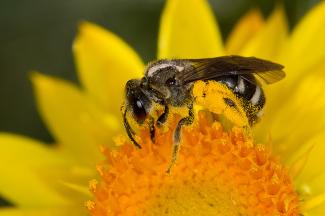
Image Credit: patrickkavanagh
Silk (or cellophane)-lining Bees (Colletidae: Colletes)
This is a very diverse group of more than 350 species in all portions of North America; many extremely abundant species that are typical of disturbed and agricultural communities. As with other members of the subfamily, they have the bent basal vein in the forewing and have complete development of the young in the first year, with mating in the fall and overwintering of the females. They are called “sweat bees” due to their universal habit of landing on people and partaking on a warm sunny day of our sweat for the sodium it contains. Unlike many other groups of bees, these “hot-tailed bees” are not averse to stinging the observer. (The irritation seldom lasts for more than 10 seconds though.) Members of these genera are found worldwide, except Australia. All the species are generalist-feeders, though they may show considerable fidelity locally. The subgenus, (or genus varying usage by specialists), Sphecodogastra, are specialists on the evening-primrose family; they are easily confused with the equally red-tailed Sphecodes cuckoo-bees (see below).
Halictus and Lasioglossum vary from completely solitary (in flowering communities with short blooming seasons, like deserts and alpine), to partially social, to truly eusocial (like the honeybee and bumblebees). Whether there is one permanent queen, several equally reproductive queens or rigidly determined division of labor varies; however, in North America all species mature within the first year, most typically late-summer to fall, mate subsequently and then the females who will become next year’s queens will hibernate for the winter. Some truly eusocial Halictus have been documented with colonies in excess of 200 individuals.
Halictus are distinguished by their typical abdominal fasciae (apical transverse bands of thick hairs) and non-iridescence; Lasioglossum by “basal fasciae” on the anterior of the abdominal segments and non-iridescence; Evylaeus by no fasciae nor iridescence; Dialictus by no fasciae and distinct iridescence at least on the head and thorax. The species are so numerous that they have never been studied in detail; most of the species in the Pacific Northwest are probably undescribed taxa. These groups are so poorly known that it is difficult the draw inclusive borders between the separate genera (or subgenera, if you prefer).

The true Sweat-bees belong to the subfamily Halictinae; they are all characterized by a wing vein that is bent just before it joins one of the major long veins of the front wing. This bent basal vein is the most distinctive character of the subfamily, but unfortunately the bee usually needs to be dead for adequate examination.


Amongst the sweat bees, Halictus (left) is recognized by the transverse apical hair bands (“fasciae”) on the abdomen and the generally dark coloration. Of all the sweat bees, Halictus is the most likely to be truly social at times. Lasioglossum (right) has BASAL hair bands on the abdomen; we have one species in the PNW with metallic green iridescence.


Dialictus (left) Evylaeus (right)
One of the subgenera of Lasioglossum is Dialictus. Since sweat-bees are quite abundant in most ecosystems, it is useful to separate them into their own genus. Dialictus (on the left) are rather small to tiny bees, without abdominal fasciae and with colorful iridescence at least on the head and thorax. There are clearly dozens of species in the PNW, but they remain very poorly studied and most are scientifically “un-named”. Dialictus are extremely abundant in sunny disturbed habitats, where they are probably the most important pollinators of small-flowered and weedy plants.
Another super-common and critical subgenus of Lasioglossum is Evylaeus (on the right). This group of species are larger that Dialictus but smaller than true Lasioglossum (strict sense). They do not have abdominal fasciae and are black (without iridescence). These are another poorly studied group with dozens of un-named species in the PNW. They favor the transition zone between meadows and forests, and are critical pollinators of native plants that would otherwise be totally ignored by the vast majority of sun-loving bee species.


The males (left) of the sweat-bees are generally slender, with a lot of yellow on the legs and often on the male clypeus. The antennae of the males are strikingly longer than those of the females. For the females (right), as a general rule, pollen transport is carried in a swollen band stretching from the 1st toe segment on the left foot all the way to the 1st toe segment on the right leg.